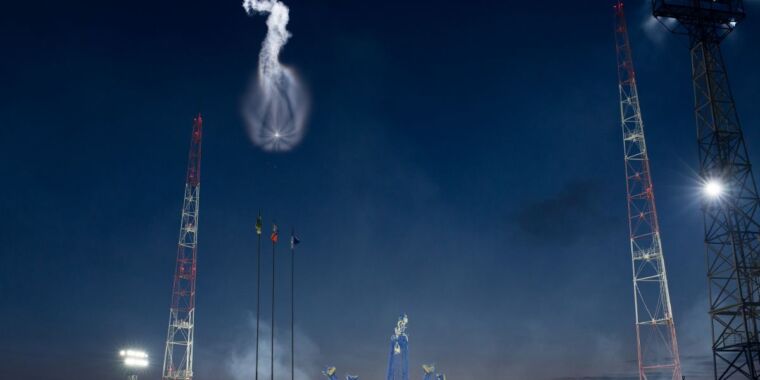A secret Russian military satellite was launched last week, deploying a payload that U.S. officials say is likely a space weapon.
In a series of statements, U.S. officials said the new military satellite, named Cosmos 2576, appears to be similar to two “inspection” spacecraft launched by Russia in 2019 and 2022.
“Just last week, on May 16, Russia launched a satellite into low earth orbit that the United States assesses is likely a counterspace weapon capable of attacking other satellites in low earth orbit,” said Robert Wood, US Deputy Ambassador to the United Nations. “Russia has placed this new counterspace weapon in the same orbit as a US government satellite.”
Cosmos 2576 flies in the same orbital plane as the National Reconnaissance Office (NRO) spy satellites, meaning it will have regular close encounters with the top-secret US reconnaissance platforms. Launched on a Soyuz rocket from Russia’s Plesetsk Cosmodrome, Cosmos 2576 was precisely timed so that the Earth’s rotation placed its launch site below the orbit of the NRO spy satellite (officially named USA 314).
The Soyuz rocket’s Fregat upper stage launched Cosmos 2576 into an orbit about 275 miles (445 km) above Earth, with an inclination of 97.25 degrees to the equator.
Conventional but of concern
For now, Cosmos 2576 is nowhere near USA 314, a bus-sized spacecraft believed to carry a powerful Earth-facing telescope to take high-resolution images for use by U.S. intelligence agencies. This type of spacecraft is commonly known as a KH-11, or Keyhole-class satellite, but its design and capabilities are top secret.
It’s not surprising that the Russian military would like to know more about some of the most closely guarded secrets about what the U.S. government is doing in orbit. Russian satellites have even flown close to Western communications satellites in geostationary orbit, presumably to eavesdrop on radio communications.
Russian Deputy Foreign Minister Sergei Ryabkov has dismissed the U.S. government’s assessment of the purpose of Cosmos 2576 as “fake news.” But in recent years, Russia has demonstrated its ability to maneuver satellites into orbits that intersect with those of U.S. spy platforms and to destroy enemy satellites in a variety of ways.
Jonathan McDowell, an astrophysicist and spaceflight event tracker, said Cosmos 2576’s current orbit would make it rare for it to come within a few hundred kilometers of USA 314. But analysts expect additional maneuvers will be performed to raise the altitude of Cosmos 2576 and put it in a position to get closer, which is what happened with two Russian satellites launched in 2019 and 2022.
Russia’s two previous satellites (Cosmos 2542 and Cosmos 2558) continually orbited within a few dozen kilometers of two other NRO satellites in low earth orbit (USA 245 and USA 326). Post to social media platform XMcDowell wrote that Russian military aircraft “tracked U.S. satellites at considerable distances but did not interfere.”
For this reason, McDowell wrote that he is “highly skeptical” that Cosmos 2576 is an anti-satellite weapon.
However, one of these Russian satellites, Cosmos 2542, released a small daughter satellite called Cosmos 2543, which passed close to the USA 245 spacecraft, a KH-11 imaging satellite similar to USA 314. At one point, satellite trackers noticed that USA 245 had slightly changed its orbit, and the Russian trackers then made similar orbital adjustments to catch up with it.
In 2020, Cosmos 2543 retreated from USA 245. A significant distance from the NRO satellite, Cosmos 2543 released a mysterious projectile into space at a speed sufficient to damage any target within view.
at that time, The U.S. Space Command hosted the event This was a “non-destructive test of a space-based anti-satellite weapon.” According to McDowell’s analysis of publicly available satellite tracking data, the projectile fired from Cosmos 2543 was fired at a relative velocity of about 400 mph (700 km/h).
The U.S. military has positioned China as its most significant strategic adversary for the coming decades. While most aspects of Russia’s space program are in decline, it still boasts a powerful anti-satellite capability; Russia intentionally destroyed one of its retired satellites with a ground-launched missile in 2021. The Russian military also fields several Peresvet laser units capable of neutralizing satellites in orbit. Russian Cyber Attacks A commercial satellite communications network was taken offline at the start of the 2022 invasion of Ukraine.
More recently, U.S. officials have alleged that Russia is developing nuclear anti-satellite weapons, a claim Russian officials have denied, but last month Russia vetoed a U.N. Security Council resolution that reiterated language in the 1967 Outer Space Treaty banning orbital weapons of mass destruction.
The U.S. military has its own constellation of orbital surveillance satellites to track other nations’ space activities, and the Space Force’s development of offensive space capabilities is classified.
“The space domain is much more challenging today than it was a few years ago,” Air Force Gen. Charles “CQ” Brown, chairman of the Joint Chiefs of Staff, said at an event hosted by the Atlantic Council on Wednesday. “We viewed space as a very benign environment and didn’t think we had to worry about conflict in space. In fact, we were prohibited from naming space a warfighting domain, but that has changed. It has changed based on what our adversaries are doing in space.”
“We don’t want our satellites to be attacked,” Brown said, “so we want to ensure that we have the ability to defend our country whether that’s in space, air, land or sea. That’s what we’re focused on as a military and that’s why we’re investing in providing the capabilities and expertise to do that.”


